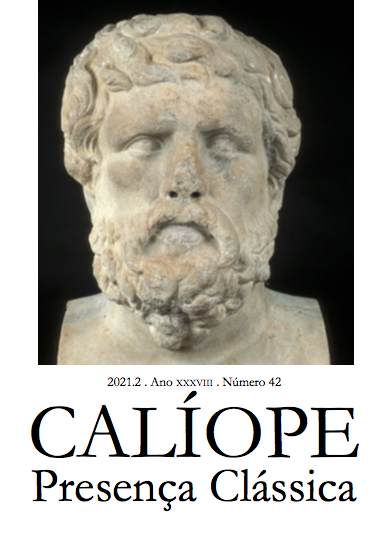Xenophon’s Cyropaedia and Plato’s Laws
DOI:
https://doi.org/10.17074/cpc.v1i42.41360Palavras-chave:
Plato and Xenophon, Herodotus, Laws, Cyropaedia, Vivienne Gray, EpinomisResumo
The passage about the flaws of Cyrus the Great in Laws 3 has led scholars both ancient and modern to conclude, accurately, that Plato was responding to Xenophon’s Cyropaedia but they have erred in assuming that this response was critical. Current scholarly debate is focused on whether Cyropaedia deserves a “sunny” reading, championed by Vivienne Gray, or a “darker” one, and this article aligns Plato with the “darker” reading: he was the first reader who demonstrably identified Cyrus himself, and specifically his inattention to the παιδεία of his sons (Lg. 694c6-7), as the cause of Persia’s post-Cyrus decline. But Cyrus must appear to embody Xenophon’s political ideal, and this explains why the text’s narrator adulates him, just as the Athenian Stranger appears to be Plato’s spokesman. Against these misconceptions, both authors use Herodotus to undermine their spokesman’s credibility, and an analysis of how they do so shows that Plato is not so much criticizing as imitating Xenophon. By aligning Plato’s Stranger with Xenophon’s Cyrus, the article argues that both Cyropaedia and Laws deserve a “darker” reading, thus creating a revealing parallel between the last chapter of Cyropedia—where Persia falls apart—and Plato’s Epinomis.
Downloads
Referências
Breebaart, A. B. 1983. “From Victory to Peace: Some Aspects of Cyrus’ State in Xenophon’s Cyrupaedia.” Mnemosyne 36, 117-134,
Burnet, John (ed.). 1901-1907. Platonis Opera, five volumes. Oxford: Clarendon Press.
Danzig, Gabriel. 2003. “Did Plato Read Xenophon’s Cyropaedia?” in Samuel Scolnicov and Luc Brisson (eds.), Plato’s Laws: From Theory into Practice: Proceedings of the VI Symposium Platonicum Selected Papers, 286-296. Sankt Augustin: Academia.
———. 2012a. “Review of Vivienne Gray, Xenophon’s Mirror or Princes.” Scripta Classica Israelica 31, 196-199
———. 2012b. “The Best of the Achaemenids: Benevolence, Self-Interest and the ‘Ironic’ Reading of Cyropaedia” in Fiona Hobden and Christopher Tuplin (eds.), Xenophon: Ethical Principles and Historical Enquiry, 499-539. Leiden and Boston: Brill.
Dorion, Louis-André. 2013. “La responsibilité de Cyrus dans le déclin de l’empire perse selon Plato et Xénophon” in Dorion, L’Autre Socrate. Études sur les écrits socratiques de Xénophon, 393-412. Paris: Les Belles Lettres.
Eichler, Gustav. 1880. De Cyrupaediae capite extreme. Grimma: C. Roessler.
England, E. B. (ed.). 1921. The Laws of Plato: The Text Edited with Introduction, Notes, etc., two volumes. Manchester: University Press, and London: Longmans, Green & Co.
Gera, Deborah Levine. 1993. Xenophon’s Cyropaedia: Style, Genre, and Literary Technique. Oxford: Clarendon Press.
Gray, Vivienne J. (ed.). 2010. Xenophon (Oxford Readings in Classical Studies). Oxford: Oxford University Press.
———. 2011. Xenophon’s Mirror of Princes: Reading the Reflections. Oxford and New York: Oxford University Press.
Gruen, Erich S. 2011. Rethinking the Other in Antiquity. Princeton and Oxford: Princeton University Press.
Hirsch, Steven W. 1985. The Friendship of the Barbarians: Xenophon and the Persian Empire. Hanover NH: University Press of New England.
Hude, Carolus (ed.). 1908. Herodoti Historiae, two volumes. Oxford: Clarendon Press.
Johnson, David. 2013. “Review of Vivienne Gray, Xenophon’s Mirror or Princes.” Classical Philology 108, 82-86.
Marchant, E. C. (ed.). 1900-1920. Xenophontis Opera Omnia, five volumes. Oxford: Clarendon Press.
McCloskey, Benjamin Orion. 2012. “Xenophon’s Kyrou Amathia: Deceitful Narrative and the Birth of Tyranny.” Ph.D. dissertation: Ohio State University.
Miller, Walter (trans.). 1914. Xenophon, Cyropaedia, two volumes. Cambridge, MA: Harvard University Press.
Mueller-Goldingen, Christian, 1995. Untersuchungen zu Xenophons Kyrupädie. Stuttgart/Leipzig: Teubner.
Schöpsdau, Klaus. 1990. “Persien und Athen in Platons Nomoi; zu Plat. Leg. III 693d-701e” in Woldemar Görler and Severin Koster (eds.), Pratum Saraviense: Festschrift für Peter Steinmetz, 25-39. Stuttgart: Palingenesia.
———. 1994. Platon, Nomoi (Gesetze): Übersetzung und Kommentar, volume 1. Göttingen: Vandenhoeck & Ruprecht.
———. 1996. “Zum ‘Tyrannenexkurs’ in Platons Nomoi” in Christian Mueller-Goldingen and Kurt Sier (eds.), with assistance from Heike Becker, ΛΗΝΑΙΚΑ: Festschrift für Carl Werner Müller zum 65. Geburtstag am Januar 1996, 133-150. Stuttgart and Leipzig: B. G. Teubner.
Stadter, Philip. 2010. “Fictional Narrative in the Cyropaedia” in Gray 2010, 367-400.
Tarán, Leonardo. 1975. Academica: Plato, Philip of Opus, and the Pseudo-Platonic Epinomis. Philadelphia, PA: American Philosophical Society.
Too, Yun Lee. 1998. “Xenophon’s Cyropaedia: Disfiguring the Pedagogical State” in Yun Lee Too and Niall Livingstone (eds.), Pedagogy and Power: Rhetorics of Classical Learning, 282-302. Cambridge, UK: Cambridge University Press.
Weil, Raymond. 1959. L’‘archeologie’ de Platon. Paris: Klincksieck.
Downloads
Publicado
Edição
Seção
Licença
Autores que publicam nesta revista concordam com os seguintes termos:
Autores mantém os direitos autorais e concedem à revista o direito de primeira publicação, com o trabalho simultaneamente licenciado sob a Licença Creative Commons Attribution que permite o compartilhamento do trabalho com reconhecimento da autoria e publicação inicial nesta revista.
Autores têm autorização para assumir contratos adicionais separadamente, para distribuição não-exclusiva da versão do trabalho publicada nesta revista (ex.: publicar em repositório institucional ou como capítulo de livro), com reconhecimento de autoria e publicação inicial nesta revista.
Autores têm permissão e são estimulados a publicar e distribuir seu trabalho online (ex.: em repositórios institucionais ou na sua página pessoal) a qualquer ponto antes ou durante o processo editorial, já que isso pode gerar alterações produtivas, bem como aumentar o impacto e a citação do trabalho publicado (Veja O Efeito do Acesso Livre).


